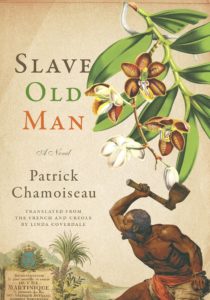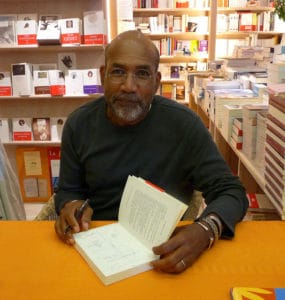The past is present…
Author: Patrick Chamoiseau
 Unexpectedly, some 177 years after her death, the Empress Joséphine was decapitated. Her headless statue still stands in downtown Fort-de-France, the capital of Martinique. An overseas region of France, the Caribbean island has a horrific history of genocide and slavery dating back to the 1600s. Joséphine’s beheading in 1991 – along with the blood red paint that was subsequently splashed on her torso – was doubtless meant as a rather bold criticism of that violent heritage and served as a symbol for the emerging Créolité movement. One of the founders of this movement – which celebrates the multi-cultural Caribbean identity of the islands in opposition to French dominance – is the novelist and native Martinican Patrick Chamoiseau. In Slave Old Man – a 1997 novel now available in a recently published English translation – he presents a uniquely powerful account of one of the slave trade’s many victims.
Unexpectedly, some 177 years after her death, the Empress Joséphine was decapitated. Her headless statue still stands in downtown Fort-de-France, the capital of Martinique. An overseas region of France, the Caribbean island has a horrific history of genocide and slavery dating back to the 1600s. Joséphine’s beheading in 1991 – along with the blood red paint that was subsequently splashed on her torso – was doubtless meant as a rather bold criticism of that violent heritage and served as a symbol for the emerging Créolité movement. One of the founders of this movement – which celebrates the multi-cultural Caribbean identity of the islands in opposition to French dominance – is the novelist and native Martinican Patrick Chamoiseau. In Slave Old Man – a 1997 novel now available in a recently published English translation – he presents a uniquely powerful account of one of the slave trade’s many victims.
Having labored for decades on a sugar plantation, the unnamed protagonist lives in perpetual fear of la décharge. A spontaneous urge to flee the plantation, it can strike suddenly like a fever, making its victim oblivious to its inherent danger. This constant threat is compared to the impulsive acts of many captives on the transatlantic slave ships who jumped overboard while in transit rather than face a horror worse than death. The old man’s fear increases with the arrival of le molosse, a monstrous mastiff that the Master has acquired to aid him in retrieving escaped slaves.
Despite his best efforts to suppress the urge for many decades, the slave eventually relents, fleeing deep into the dark jungle and throwing all caution to the wind. Quick to respond, the Master clearly lives for these moments, reveling in the opportunity to deploy his new canine weapon of death. But the old man – no longer slave – has weapons of his own, drawing on his inner strength and the power of his ancestors.
It’s a tragically simple story, but in the author’s hands it’s an entirely unique experience. Known for his enthusiastic “freeform” use of language, Chamoiseau energetically melds moments of violent realism with copious dreamlike imagery, creating a story that’s as magical as it is horrific.
“The old man slave does not remember the ship, but in a way he is still down in its hold.”
Maybe the most interesting part of the story is how the past – genocide and slavery – imbues all things. Even though the old man never spent any time on the ships that brought his ancestors to Martinique, their experiences – combined with the genocidal miseries of the island’s original human inhabitants – motivate him, pushing him toward an inner freedom despite the harsh externalities. Constantly weaving, the author manages to combine the past and present, making them virtually indistinguishable.
If it’s not already obvious, the story can get a bit confusing at times. Fortunately, Linda Coverdale – the fearless translator – is here to help. Not only does she manage to capture Chamoiseau’s style of “extravagant invention”, she provides numerous notes to help explain details about Martinican language, culture and history. Without her extra efforts, the English reader would be hopelessly lost.
I have to admit, Slave Old Man is not a book for everyone. Its experimental aspects often prove challenging. But I do think it’s worth the effort for any reader with a healthy bit of literary courage. It’s a remarkably passionate and imaginative work that stimulated me to read more and explore a part of the world of which I knew very little.
— D. Driftless
Forest photo from Wikimedia Commons (CC BY-SA 3.0)/author photo by Ji-Elle (CC BY-SA 3.0)
Readers Lane reviews of other books about slavery: Barracoon / Twelve Years a Slave / Uncle Tom’s Cabin
[AMAZONPRODUCTS asin=”1620972956″]
- Best Non-Fiction of 2016 - February 1, 2017
- Little Free Library Series — Savannah - May 22, 2015
- Little Free Library Series — Wyoming - November 30, 2014




